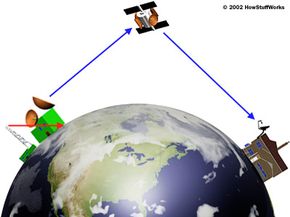Problems with Broadcast TV
Conceptually, satellite TV is a lot like broadcast TV. It's a wireless system for delivering television programming directly to a viewer's house. Both broadcast television and satellite stations transmit programming via a radio signal (see How Radio Works for information about radio broadcasting).
Broadcast stations use a powerful antenna to transmit radio waves to the surrounding area. Viewers can pick up the signal with a much smaller antenna. The main limitation of broadcast TV is range. The radio signals used to broadcast television shoot out from the broadcast antenna in a straight line. In order to receive these signals, you have to be in the direct line of sight of the antenna. Small obstacles like trees or small buildings aren't a problem; but a big obstacle, such as the Earth, will reflect these radio waves.
Advertisement
If the Earth were perfectly flat, you could pick up broadcast TV thousands of miles from the source. But because the planet is curved, it eventually breaks the signal's line of sight. The other problem with broadcast TV is that the signal is often distorted, even in the viewing area. To get a perfectly clear signal like you find on cable, you have to be pretty close to the broadcast antenna without too many obstacles in the way.
The Satellite TV Solution
Satellite TV solves the problems of range and distortion by transmitting broadcast signals from satellites orbiting the Earth. Since satellites are high in the sky, there are a lot more customers in the line of sight. Satellite TV systems transmit and receive radio signals using specialized antennas called satellite dishes.
